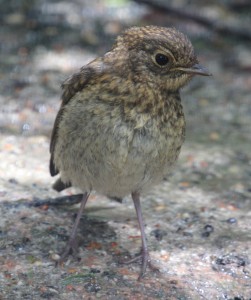 So the result of the campaign to find Britain’s first National Bird has been announced in Springwatch on BBC TV. Not surprisingly the top of the list, by far as it happens, is the robin with 34% of votes. Robins are a favourite bird in gardens, even this year’s brown spotted young birds as in the photograph I took in the garden. In contrast the runner-up, at 12%, was, surprisingly, the barn owl. During the vote it was apparent for some time that the blackbird would be in second place but when the children’s votes were counted the barn owl took over in second place. The blackbird had 11% of the votes so was just pipped at the post by the barn owl. The BBC Springwatch presenter, David Lindo, began the project last year as he, and many others, believe that Britain should have a National Bird like many other countries. More than 224,000 people voted on line, at ballot boxes in schools and by post. As for the bird I voted for, the wren, it came in fourth place followed by the red kite and the kingfisher. The mute swan came in 7th in the vote followed by the blue tit, hen harrier and the puffin.
So the result of the campaign to find Britain’s first National Bird has been announced in Springwatch on BBC TV. Not surprisingly the top of the list, by far as it happens, is the robin with 34% of votes. Robins are a favourite bird in gardens, even this year’s brown spotted young birds as in the photograph I took in the garden. In contrast the runner-up, at 12%, was, surprisingly, the barn owl. During the vote it was apparent for some time that the blackbird would be in second place but when the children’s votes were counted the barn owl took over in second place. The blackbird had 11% of the votes so was just pipped at the post by the barn owl. The BBC Springwatch presenter, David Lindo, began the project last year as he, and many others, believe that Britain should have a National Bird like many other countries. More than 224,000 people voted on line, at ballot boxes in schools and by post. As for the bird I voted for, the wren, it came in fourth place followed by the red kite and the kingfisher. The mute swan came in 7th in the vote followed by the blue tit, hen harrier and the puffin.
The barn owl, at second, was a surprise but there has been a great deal of publicity over this bird down south. There are around 5,000 pairs in the UK and it is thought that half of these now breed in nestboxes provided by man. Now that is a wildlife conservation achievement of some note. The last place was filled by the puffin but this did not come as surprise as many people just do not see the puffin as it is strictly a coastal breeding bird and even then spends most of its time at sea for the winter months. Presumably one reason the robin was the favourite was because we see them so much in the garden but if that is the case why is the blue tit so far down the list at 8th place? After all the blue tit is one of the commonest birds at the peanut feeders in gardens. The mute swan seems to have its rightful place at 7th but it seems surprising that the hen harrier even made the last list of ten birds. However, there has been so much publicity over the plight of the hen harrier being persecuted down in England in recent years which may have tipped the balance.
So, after all the publicity, just what does this mean? The interesting aspect of all this is that this is not the official bird as that has to be ratified by the government and I understand this is all now underway. Hopefully this will be a formality as we should follow the lead of other countries in having a National Bird. The robin does not compare in size to the United States National Bird which is the American bald eagle that has held this status since 1782 and appears on the US seal. Then there is the colourful peacock that is the National Bird of India. The French representative is what is called the Gallic Rooster, our cockerel, and I always look for one on the pitch at International rugby matches although it defeats me how they smuggle the bird on the pitch! The robin will be more than a British symbol as it will prompt many more people to look at birds and wildlife which can only a be a good thing as a great deal of wildlife is now in trouble for a wide range of reasons.
Tags: highland wildlife
